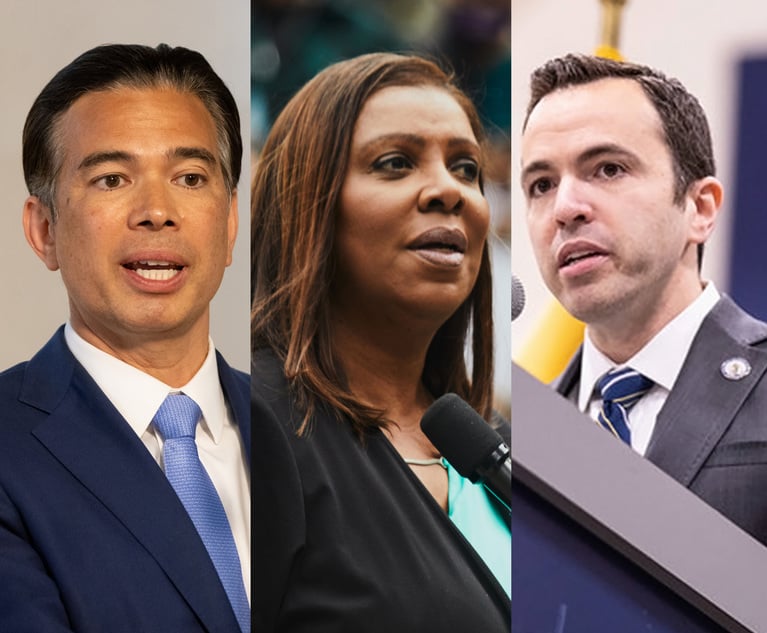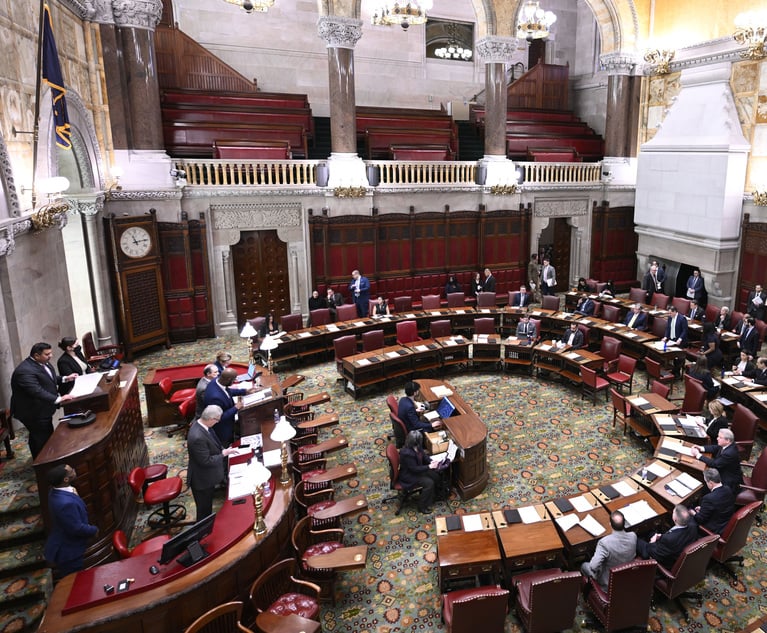How Courts Paved the Way for the Eruv
Over the years, courts in New York and the region have issued a number of decisions regarding challenges to a local government's willingness, or unwillingness, to allow the establishment of an eruv as an accommodation to Orthodox Jews. In this Religion Law column, Barry Black explores this issue.
February 28, 2019 at 02:45 PM
8 minute read
 Barry Black
Barry Black
The faith of Orthodox Jews forbids them from pushing or carrying objects outside their homes on the Sabbath and on Yom Kippur. In accordance with a religious convention practiced for over 2,000 years, however, Orthodox Jews are relieved from such prohibitions within an eruv, which is a ritual demarcation of an area.
Centuries ago, an eruv would have been built using ropes and wooden poles. Nowadays, as described several years ago by the U.S. District Court for the Eastern District of New York, an eruv is an unbroken delineation of an area created by using telephone poles, utility poles, wires, and already-existing boundaries, and by attaching “lechis” to the sides of the poles. See East End Eruv Ass'n v. Town of Southampton, No. CV 13-4810 (AKT) (E.D.N.Y. Sept. 24, 2014). Lechis are typically hard plastic strips of the type generally used to cover wires on utility poles. Unless one knows which plastic strips are lechis and which are utility wire covers, it may be virtually impossible to distinguish the two.
Given that the lechis can be essentially unnoticeable, it might be somewhat surprising to discover that eruv litigation goes back decades. See, e.g., Smith v. Community Board No. 14, 128 Misc. 2d 944 (Sup. Ct. Queens Co. 1985); see also American Civil Liberties Union v. Long Branch, 670 F. Supp. 1293 (D.N.J. 1987). In many instances, these lawsuits have been hard fought. See, e.g., East End Eruv Ass'n v. Westhampton Beach, 828 F. Supp. 2d 526 (E.D.N.Y. 2011); East End Eruv Ass'n v. Town of Southampton, No. CV 13-4810 (AKT), supra; East End Eruv Ass'n, Inc. v. Westhampton Beach, Nos. CVs 11-213, 11-252 (AKT) (E.D.N.Y. Sep. 30, 2015).
Beyond the volume and intensity of eruv litigation is the wide range of legal issues involved, from property rights and easements to zoning and land use issues. See, e.g., East End Eruv Association v. Town of Southampton, No. 14-21124 (Sup. Ct. Suffolk Co. July 14, 2015).
Eruv litigation commonly involves the Free Exercise Clause of the First Amendment. A 2002 decision out of New Jersey by the U.S. Court of Appeals for the Third Circuit, Tenafly Eruv Ass'n v. Borough of Tenafly, 309 F.3d 144 (3d Cir. 2002), highlights the rationale many courts have adopted to analyze the free exercise issues raised by a request for authorization to establish an eruv, and by the opposition to such a request.
Background
The Tenafly case arose after the county executive of Bergen County, N.J., issued a ceremonial proclamation validating an eruv for the borough of Tenafly. The telephone company that owned the utility poles in Tenafly granted permission to Orthodox Jewish residents to attach lechis to its utility poles. The eruv was completed with the help of the local cable television provider.
Thereafter, after referencing a local ordinance that generally barred signs on any pole on a public street (Ordinance 691), Tenafly officials ordered the cable company to take the lechis off the utility poles “as soon as possible.” Several individuals together with the Tenafly Eruv Association, Inc. (TEAI), an organization formed to promote the creation of an eruv in Tenafly, brought suit.
The U.S. District Court for the District of New Jersey denied the plaintiffs' request for injunctive relief on the ground that they were not reasonably likely to succeed on the merits of any of their claims. The plaintiffs appealed to the Third Circuit, which reversed and entered an order directing the district court to issue a preliminary injunction barring Tenafly from removing the lechis.
Third Circuit's Decision
The heart of the court's decision was its analysis of the plaintiffs' claims under the Free Exercise Clause.
The court explained that, depending on the nature of a challenged law or government action, a free exercise claim could prompt either strict scrutiny or rational basis review. Citing the U.S. Supreme Court's decision in Employment Division, Department of Human Resources of Oregon v. Smith, 494 U.S. 872 Ct. (1990), which held that the Free Exercise Clause did not require a state to exempt the ingestion of peyote during a Native American church ceremony from its neutral, generally applicable prohibition on using that drug, the court said that if a law was “neutral” and “generally applicable,” and burdened religious conduct only incidentally, the Free Exercise Clause offered no protection.
On the other hand, citing to the Supreme Court's opinion in Church of the Lukumi Babalu Aye, Inc. v. City of Hialeah, 508 U.S. 520 (1993), where a city enacted ordinances that purportedly were intended to prevent cruelty to animals by precluding their ritual slaughter but that were in fact targeted at the Santeria religion, the Third Circuit explained that where government officials exercised discretion in applying a facially neutral law, such as when they discriminated in enforcing the law, they contravened the neutrality requirement if they exempted some secularly motivated conduct but not comparable religiously motivated conduct, strict scrutiny applied, and the burden on religious conduct violated the Free Exercise Clause unless it was narrowly tailored to advance a compelling government interest.
The court pointed out that because Ordinance 691 was neutral and generally applicable on its face, if Tenafly had enforced it uniformly, Smith would have controlled and the plaintiffs' free exercise claim would have failed. The court found, however, that Tenafly had not enforced Ordinance 691 uniformly. Rather, the court said, Tenafly had tacitly or expressly granted exemptions from the ordinance's “unyielding language” for various secular and religious – although never Orthodox Jewish – purposes, such as by permitting private citizens to affix house numbers, lost animal signs, holiday displays, and church directional signs to its utility poles.
The court then decided that Tenafly's “selective, discretionary application of Ordinance 691 against the lechis” violated the neutrality principle of Lukumi because it devalued Orthodox Jewish reasons for posting items on utility poles by “judging them to be of lesser import than nonreligious reasons” and, therefore, singled out the plaintiffs' religiously motivated conduct for discriminatory treatment. Accordingly, the court ruled that it had to apply strict scrutiny to Tenafly's application of Ordinance 691 to the lechis.
The court next determined that Tenafly's decision to remove the lechis did not withstand strict scrutiny. The court reasoned that even if Tenafly had a compelling interest in preventing permanent fixtures on its utility poles, its decision to remove the eruv was not narrowly tailored to promote that interest.
The court rejected Tenafly's argument that leaving the eruv in place would constitute an actual violation of the First Amendment's Establishment Clause and that the need to avoid such a violation justified discrimination against the plaintiffs' religiously motivated conduct. The court explained that if Tenafly ceased discriminating against the plaintiffs' religiously motivated conduct to comply with the Free Exercise Clause, “a reasonable, informed observer would not perceive an endorsement of Orthodox Judaism” because Tenafly's change of heart would “reflect[] nothing more than the governmental obligation of neutrality” toward religion.
In other words, the court continued, the “reasonable, informed observer” would know that the lechis were items with religious significance that enabled Orthodox Jews to engage in activities otherwise off limits on the Sabbath and Yom Kippur, but also would know that Tenafly was allowing them to remain on the utility poles only because its selective application of Ordinance 691 rendered removing the lechis a free exercise violation.
The court pointed out that there was a “vital difference” between purely private religiously motivated conduct and conduct initiated or sponsored by government, adding that no reasonable, informed observer would perceive the decision of the plaintiffs to affix lechis to utility poles owned by the telephone company and to do so with the cable company's assistance as a choice attributable to the government. Similarly, the court added, because the eruv was maintained solely with private funds, and because allowing the lechis to remain in place would represent neutral rather than preferential treatment of religiously motivated conduct, “no reasonable, informed observer” would believe that Tenafly was “affirmatively sponsoring” an Orthodox Jewish practice.
Therefore, the Third Circuit concluded, because the plaintiffs were reasonably likely to show that Tenafly had violated the Free Exercise Clause by applying Ordinance 691 selectively against conduct motivated by Orthodox Jewish beliefs, the district court should have preliminarily enjoined Tenafly from removing the lechis.
Conclusion
By now, a municipality facing a request to establish an eruv should be able to approve the application with little fanfare where the eruv is to consist of lechis that are, for all intents and purposes, unnoticeable. As numerous courts have decided over the years, when handled properly, there should be no Free Exercise Clause issues in these situations. On the other hand, a local government that fails to approve such a request in a way that unfairly singles out the religious views of the applicants and is challenged in court is unlikely to have the court uphold its decision.
Barry Black is a partner in the religion law firm Nelson Madden Black, which serves the legal needs of religious institutions and individuals. Resident in the firm's offices in Midtown Manhattan, he can be reached at [email protected].
This content has been archived. It is available through our partners, LexisNexis® and Bloomberg Law.
To view this content, please continue to their sites.
Not a Lexis Subscriber?
Subscribe Now
Not a Bloomberg Law Subscriber?
Subscribe Now
NOT FOR REPRINT
© 2025 ALM Global, LLC, All Rights Reserved. Request academic re-use from www.copyright.com. All other uses, submit a request to [email protected]. For more information visit Asset & Logo Licensing.
You Might Like
View All

Federal Judge Pauses Trump Funding Freeze as Democratic AGs Plan Suit
4 minute read
Relaxing Penalties on Discovery Noncompliance Allows Criminal Cases to Get Decided on Merit
5 minute read
Bipartisan Lawmakers to Hochul Urge Greater Student Loan Forgiveness for Public-Interest Lawyers
Trending Stories
- 1Uber Files RICO Suit Against Plaintiff-Side Firms Alleging Fraudulent Injury Claims
- 2The Law Firm Disrupted: Scrutinizing the Elephant More Than the Mouse
- 3Inherent Diminished Value Damages Unavailable to 3rd-Party Claimants, Court Says
- 4Pa. Defense Firm Sued by Client Over Ex-Eagles Player's $43.5M Med Mal Win
- 5Losses Mount at Morris Manning, but Departing Ex-Chair Stays Bullish About His Old Firm's Future
Who Got The Work
J. Brugh Lower of Gibbons has entered an appearance for industrial equipment supplier Devco Corporation in a pending trademark infringement lawsuit. The suit, accusing the defendant of selling knock-off Graco products, was filed Dec. 18 in New Jersey District Court by Rivkin Radler on behalf of Graco Inc. and Graco Minnesota. The case, assigned to U.S. District Judge Zahid N. Quraishi, is 3:24-cv-11294, Graco Inc. et al v. Devco Corporation.
Who Got The Work
Rebecca Maller-Stein and Kent A. Yalowitz of Arnold & Porter Kaye Scholer have entered their appearances for Hanaco Venture Capital and its executives, Lior Prosor and David Frankel, in a pending securities lawsuit. The action, filed on Dec. 24 in New York Southern District Court by Zell, Aron & Co. on behalf of Goldeneye Advisors, accuses the defendants of negligently and fraudulently managing the plaintiff's $1 million investment. The case, assigned to U.S. District Judge Vernon S. Broderick, is 1:24-cv-09918, Goldeneye Advisors, LLC v. Hanaco Venture Capital, Ltd. et al.
Who Got The Work
Attorneys from A&O Shearman has stepped in as defense counsel for Toronto-Dominion Bank and other defendants in a pending securities class action. The suit, filed Dec. 11 in New York Southern District Court by Bleichmar Fonti & Auld, accuses the defendants of concealing the bank's 'pervasive' deficiencies in regards to its compliance with the Bank Secrecy Act and the quality of its anti-money laundering controls. The case, assigned to U.S. District Judge Arun Subramanian, is 1:24-cv-09445, Gonzalez v. The Toronto-Dominion Bank et al.
Who Got The Work
Crown Castle International, a Pennsylvania company providing shared communications infrastructure, has turned to Luke D. Wolf of Gordon Rees Scully Mansukhani to fend off a pending breach-of-contract lawsuit. The court action, filed Nov. 25 in Michigan Eastern District Court by Hooper Hathaway PC on behalf of The Town Residences LLC, accuses Crown Castle of failing to transfer approximately $30,000 in utility payments from T-Mobile in breach of a roof-top lease and assignment agreement. The case, assigned to U.S. District Judge Susan K. Declercq, is 2:24-cv-13131, The Town Residences LLC v. T-Mobile US, Inc. et al.
Who Got The Work
Wilfred P. Coronato and Daniel M. Schwartz of McCarter & English have stepped in as defense counsel to Electrolux Home Products Inc. in a pending product liability lawsuit. The court action, filed Nov. 26 in New York Eastern District Court by Poulos Lopiccolo PC and Nagel Rice LLP on behalf of David Stern, alleges that the defendant's refrigerators’ drawers and shelving repeatedly break and fall apart within months after purchase. The case, assigned to U.S. District Judge Joan M. Azrack, is 2:24-cv-08204, Stern v. Electrolux Home Products, Inc.
Featured Firms
Law Offices of Gary Martin Hays & Associates, P.C.
(470) 294-1674
Law Offices of Mark E. Salomone
(857) 444-6468
Smith & Hassler
(713) 739-1250






